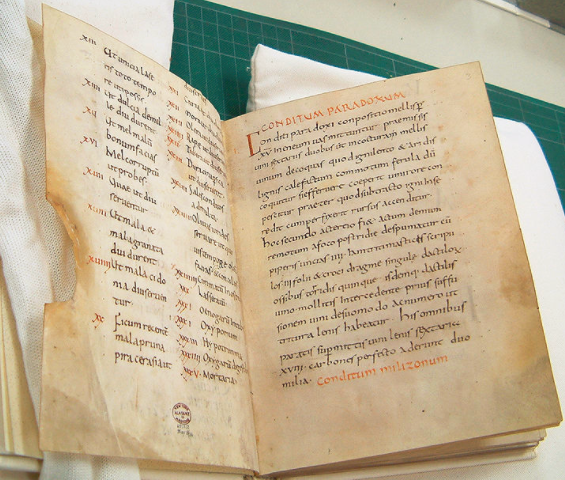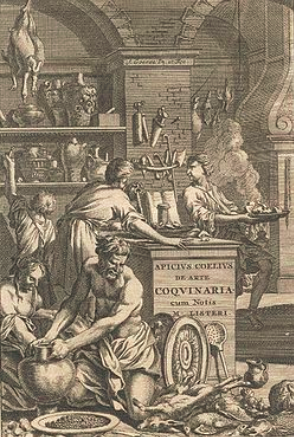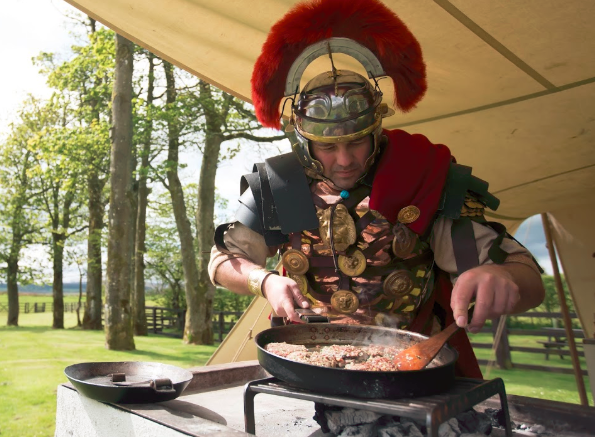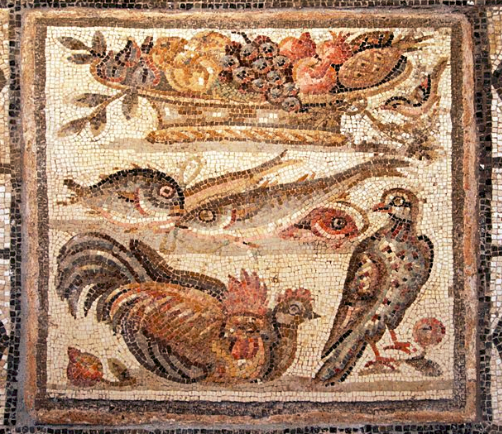
Salvete readers and history-lovers!
Well, Summer has finally arrived in the northern hemisphere, and that means dining al fresco with friends and family, sunny days (one hopes!), and time spent beside bodies of water.
It also means people will be firing up their barbecues! And so, with the upcoming North American holidays of Canada Day (July 1st) and Independence Day in the USA (July 4th), I thought it would be fun to talk briefly about food!
This isn’t just a history post about food in ancient Rome. It’s a practical post, because at the end I’m going to share a recipe with you that is easily done. But first…
We can’t really have a discussion about food in ancient Rome without talking about one man in particular.
He was the gastronome du jour during the reigns of Augustus and Tiberius, and his recipes were used for hundreds of years after his passing.
I’m speaking, of course, about Apicius, or, more formally Marcus Gavius Apicius (25 B.C. – A.D.37).

An imagined likeness of Apicius
Apicius was a man who was largely concerned with fine living and fine food in ancient Rome and his work ‘On Cookery’, also known as ‘Cookery and Dining in Imperial Rome’, which has come down to us, is chock-full of recipes from wines and oils, to desserts, sauces, broths, a lovely array of vegetables, and spices.
There is also a lot about different meats and sea foods, and their preparation and uses, and several of them are quite disturbing if not entertaining.
Apicius’ ‘book’ might have been a sort of Julia Child cookery book of the ancient world, widely used in the kitchens of well-to-do Romans. Here is a picture of a manuscript copy from the A.D. 900:

Apicius manuscript from A.D. 900 (Wikimedia Commons)
When I think of Roman cooking, the first things that I imagine are outlandish dishes and meats that I would never consider eating myself. And if you peruse Apicius, you will indeed read about some things abhorrent to your modern tastes.
Book II of Apicius, dealing with ‘Minces’ includes recipes for Isicia de cerebellis (bain sausage),and Vulvulae Botelli (a dish of sow’s matrix). Or how about Book IV which deals with ‘Miscellanea’ such as Patina Frisilis (vegetable and brain pudding)?
Book VII on ‘Sumptuous Dishes’ has recipes for Vulvae Steriles (spayed sow’s womb), andAliter in Pulmonibus (another way to cook lung). Because I guess, one needs choices when cooking lung!
And then there is everyone’s favourite in Book VIII on ‘Quadrupeds’ which goes into detail about Glires (stuffed dormice).

Dormice – Would you eat these cute little guys? The Romans would!
If you read through the text of Apicius, however, you will see that most of the dishes are quite appealing. There are a lot of wonderful vegetable dishes, and some recipes for meats that would make your mouth water.
With that – and BBQ season – in mind, I thought I would share one of Apicius’ more well-known recipes with you.
What is it?
Hamburgers.
Yes. You heard that correctly. Hamburgers, or, to be more precise, Isicia Omentata.
So, how do you make hamburgers from a 2000 year-old recipe? Let’s see what Apicius says in Book II (chapter 1, 47) on ‘Minces’:
Finely cut pulp of pork is ground with the hearts of winter wheat [fine wheat flour or cream of wheat] and diluted with wine. Flavor lightly with pepper and broth and if you like add a moderate quantity of myrtle berries also crushed, and after you have added crushed nuts and pepper [pepper corns or allspice] shape the forcemeat into small rolls, wrap these in caul, fry, and serve with wine gravy. (Apicius on Cookery)
That’s it. Not much to go on, but the basic ingredients are there. Beef was not as commonly eaten, so it is not surprising that pork was the meat of choice, though you could make this with just about any kind of mince, including a modern veggie mince option.

Order up!
Another translation of the text reveals some different ingredients too. Here is a simplified version:
500g minced meat (or a vegan mince substitute)
60g pine kernels
3 tsp. Garum (Roman fish sauce – you can use a fish sauce from the grocery store, or just regular sea salt)
Ground pepper
Handful of coriander
Juniper berries (optional) – this is a coniferous berry that is used in cooking, but be sure to buy the edible kind, for some species, like Juniperus sabina, are toxic!
Caul fat (optional) – this is the thin membrane which surrounds the internal organs of some animals

Reenactor, Joe Jackson, making Roman Burgers at Birdoswald Roman Fort (Photo by English Heritage)
I admit that I had to look up what ‘Caul fat’ is and, well, I think I would leave that part out. The meat will hold together without it if you use bread or wheat in the mixture. As with many Roman dishes in Apicius, the spices are exotic and interesting, so whether you opt for a meaty or meat-free version of this recipe, it should be a tasty treat hot off the grill!
If you try this out, let us know how it goes in the comments, and whether or not you made any adjustments to the recipe.
To read the full text of Apicius, you can do so for free on the Project Gutenberg website here: http://www.gutenberg.org/ebooks/29728
Have a look at the dishes throughout. You never know! You might just have the makings of a Roman BBQ fit for an emperor!
Thank you for reading!



